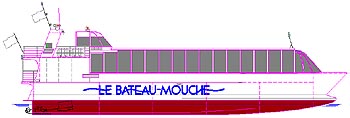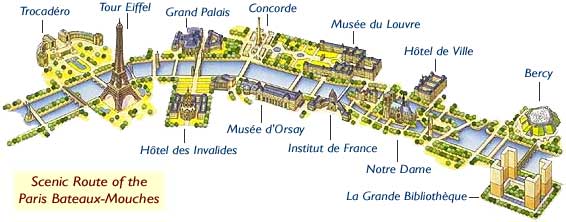 |
 |
 |
| |||||||||||||


|
|
|||
Introduction
The modern Bateau-Mouche, a design ideal for navigating shallow rivers and canals. (drawing © Bateau Mouche International) The waters of the River Seine have always been the heart and soul of Paris, dating back to the days when the Parisii tribe first established a fishing village on the island now known as Île de la Cité — between 250 and 200 B.C. Prized for its position as a major inland port, Paris has been invaded, occupied, and conquered by its share of foreigners over the course of two millennia, many of whom arrived by this waterway. The last major invasion by water occurred between 885 and 886 A.D., when 30,000 Norman pirates in 700 ships sailed up the Seine, only to find it valiantly defended by Comte Eudes. Ever since the days of the Roman Empire, when Paris prospered through extensive river trading and expanded to the Left Bank, the Seine has been a great commercial artery, linked by canals to the Loire, Rhine, and Rhône rivers. Officially established as the capital city by Clovis, king of the Franks (who defeated the Roman governor of Gaul and established the Merovingian dynasty), Paris evolved into a cultural center and a showcase of glorious architecture. It is appropriate that the center of Paris — particularly that section gracing the Seine around Île de la Cité and Île Saint-Louis — features some of the city's oldest and most majestic historic monuments. For the past half-century, perhaps one of the most relaxing and expedient ways to view these sights in all their grandeur has been from the glass-covered decks of the bateaux-mouches, those unique long-boats leisurely plying the Seine, from whose vantage point millions of tourists have acquired their considerable appreciation for all that Paris has to offer. On some days, the sheer volume of this boat traffic resembles an invasion of a different kind, albeit one of camera shutters and tourists gazing in wonderment.  (click on any monument to learn about it) There appears to be some conjecture as to the origin of the term bateaux-mouches (whose literal translation is "fly-boats"). Some have asserted that the name of the oldest operating cruise line on the Seine — la Compagnie des Bateaux-Mouches — originates from that of its founder, a gentleman by the name of Jean-Sébastien Mouche. However, this legend is generally conceded to be a hoax. A more likely scenario is that the name was derived from an area of Lyon where the predecessors of these boats were first built by the Félizate shipyard in 1863, before being introduced to Paris at the end of the 19th century. The various arms of the Rhône River — in a marshy area of the river valley around Lyon — were called "mouches". Apparently, the boats — whose shallow hulls were well-suited for the purpose — were commonly found navigating these "mouches". In fact, while much of the marsh land has been drained and added to Lyon's viable real estate, one of its neighborhoods (a part of the 7th arrondissement) is still called La Mouche today. There is another theory on the origins of the term, one which is based on an entry in Robert historique de la langue française (Le Robert, 1992-1998, volume II, p. 2300, article "mouche"). The entry states that the word mouche was once a colloquial — or slang — expression for "spy" (see modern word: mouchard). With this in mind, the nickname of mouche was conferred upon a small warship in 1814, and subsequently to a small steamship in 1867 — thus bateau-mouche was adopted to designate any similarly styled vessel. At any rate, as the popularity of these sight-seeing vessels flourished in Paris after the second World War, la Compagnie des Bateaux-Mouches has seen growing competition from a number of operators with similar vessels. Thus, over the years, the term bateaux-mouches has come to signify all such boats catering to tourists on the Seine, regardless of operator or even a specific vessel configuration. Some of them look like glorified barges, while others qualify as luxury yachts. Hull designs vary, though the modern boats employ either a catamaran or trimaran hull. Passenger capacity generally ranges from 200 to 350 per vessel. The SightsDespite the ever-increasing number of operators (and embarcation points) from which to choose, most of the boat lines offer similar itineraries, tracing the scenic route shown in the illustration above. Some operators also offer land-and-water packages, where the price of a ticket includes debarkation at various points to visit monuments, museums, or even cabaret venues such as the Moulin Rouge or the Lido. (Please refer to individual descriptions for each company.) 
The Pont-Neuf bridge on the River Seine (Samaritaine department store in background). Source: FreeFoto.com In addition to the historic landmarks lining the Seine, travelers can't help but notice the many splendid bridges which span the river (35 in all), some of them several centuries old and designated as Historical Heritage sites in their own right. Ironically, the oldest of these is the Pont-Neuf, whose first stone was laid in 1578 by Henri III in the presence of the Queen Mother, Catherine de Médicis. The newest one, completed in the summer of 1996, is the Pont Charles de Gaulle — built to accommodate the recent influx of traffic from various grands projets (e.g. the Bercy sports arena, the Grande Bibliothèque, etc.). Most of the boats are equipped with a text display and an audio announcement system, synchronized to the boat's movement and providing commentary on the passing sights in several different languages. In nice weather, these tours offer a pleasant and relaxing way to view Paris' most famous landmarks in a single hour — certainly worth the modest price for a ticket. A night-time cruise is perhaps the most stunning: the boats are equipped with huge floodlights illuminating the riverside monuments, so bright that their glow is visible throughout the city on cloudy or foggy nights. For those travelers who wish to combine their dining experience with majestic moving scenery, there are a number of operators providing lunch and dinner cruises. Several of these are reputed to offer gourmet fare from highly regarded chefs, and the prices of these tours are commensurate with the degree of luxury offered. Other CitiesOwing to their great popularity in Paris, other cities have also adopted the bateaux-mouches as a tourist venue. Some of these include Annecy, Charleville-Mézières, Nantes, Strasbourg, Toulouse, Maastricht (Netherlands), Montreal (Canada), the island of Guadeloupe, and seven metropolitan centers in the U.S. (Boston, Chicago, New York, Norfolk, Philadelphia, Richmond, Seattle).
Author: Ian C. Mills ©2002- — All Rights Reserved. Sources: Anthony's Home Page, web site hosted by Anthony G. Atkielski. A Basic Paris Glossary, from The Paris Pages web site, hosted by Norman Barth Relevant publications: Philip Trager, Changing Paris: A Tour Along the Seine (2000). Frances Y. McHugh, Window on the Seine (2001). Mort Rosenblum, The Secret Life of the Seine (2001). William Wharton, Houseboat on the Seine (1996). Robert Gibbings, Coming Down the Seine (2002). Gerald Kenneth Geerling, Paris Along the Seine (1988). Images: Line drawing of Le Bateau Mouche trimaran vessel, from Bateau Mouche International (shipbuilders) and Le Bateau Mouche au Vieux Port de Montréal (offering daily cruises on the St. Lawrence River). Map of scenic route along the Seine in Paris, from Bateaux Parisiens (image edited by Ian C. Mills, webmaster of DiscoverFrance.net) — All Rights Reserved. The Pont-Neuf bridge on the River Seine (Samaritaine department store in background), from FreeFoto.com — All Rights Reserved. Company logos are copyrighted by their respective owners. Next page >> Bateaux Parisiens |
||

|
||||||||||